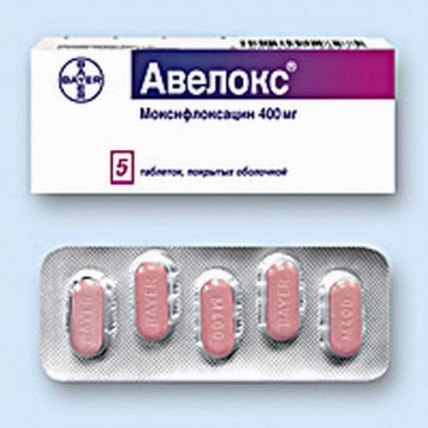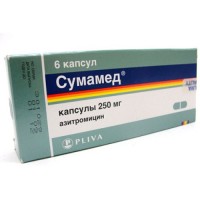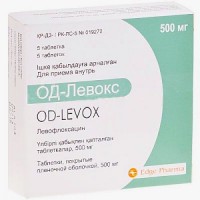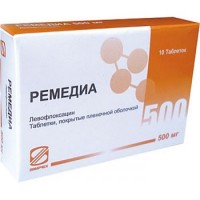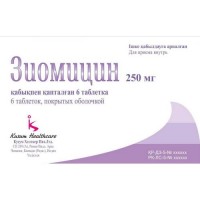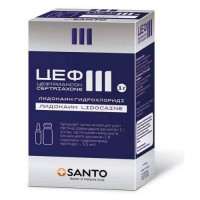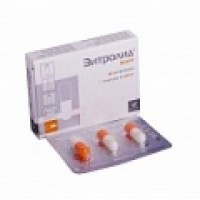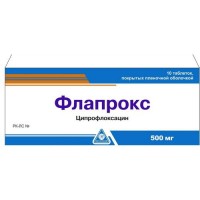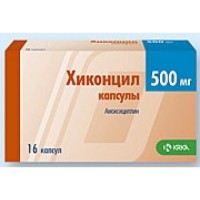Avelox 5's 400 mg coated tablets
- $58.00
The instruction for medical use
of Avelox Torgovoye medicine a name
of Avelox
the International unlicensed
name Moxifloxacin Dosage Form
of the Tablet, coated, 400 mg
Structure
One tablet contains
active agent - a moksifloksatsin a hydrochloride of 436.8 mg,
(it is equivalent to a moksifloksatsin of 400.0 mg),
excipients: lactoses monohydrate, cellulose microcrystalline, croscarmellose sodium, magnesium stearate,
structure of a cover: red ferrous oxide, gipromelloza, macrogoal 4000, titan dioxide.
The description
of the Tablet of red and opaque color, oblong shape, the coated, about 17 mm long and about 7 mm wide, having marking on one party M 400, and on other BAYER.
Pharmacotherapeutic group
Antibacterial drugs for system use.
Ftorkhinolona.
The code of automatic telephone exchange J01MA14
the Pharmacological
Pharmacokinetics Absorption properties and bioavailability
At oral administration moxifloxacin is soaked up quickly and almost completely. The absolute bioavailability is about 91%.
The pharmacokinetics of a moksifloksatsin at reception in a dose from 50 to 1200 mg once and also on 600 mg/days within 10 days is linear. The equilibrium state is reached within 3 days.
After single purpose of 400 mg of a moksifloksatsin the maximum concentration (With max) in blood is reached within 0.5-4 hours and makes 3.1 mg/l. Peak and minimum concentration in plasma in a stable state (400 mg once daily) were 3.2 and 0.6 mg/l, respectively.
At reception of a moksifloksatsin together with food the insignificant increase in time of achievement of Cmax is noted (for 2 hours) and insignificant decrease in Cmax (approximately for 16%), at the same time duration of absorption does not change. However, these data have no clinical value as AUC/MIC ratio more predicts antimicrobic activity of hinolon. Therefore, drug can be used irrespective of meal.
Distribution
Moxifloxacin is very quickly distributed in the extravasated course. The big area under pharmacokinetic curve AUC (AUCnorm = 6 kg*chasov/l) with an equilibrium volume of distribution (Vss) of a moksifloksatsin about 2 l/kg is observed. Peak concentration of a moksifloksatsin in saliva is higher, than in plasma. In researches in-vitro and in-vivo in the range of concentration from 0.02 to 2ml/l linking of a moksifloksatsin with proteins made about 45% irrespective of concentration of drug.
Moxifloxacin generally contacts plasma albumine.
The high peak of free concentration & gt, 10xMIC in connection with low volume is observed.
The high concentrations of drug exceeding those in plasma are created in pulmonary fabric (epithelial liquid, alveolar macrophages, biological fabric), in nasal bosoms and polyps, in the inflammation centers. In saliva, interstitial liquid (intermuscular and hypodermic) high concentration of drug in a stand-at-ease is defined.
Besides, high concentrations of drug are defined in abdominal organs and peritoneal liquid and also in female genitals.
After a single dose of a moksifloksatsin of 400 mg at both ways of introduction comparable maximum concentration in comparison with plasma concentration in various target tissues were observed.
Metabolism
After passing of the 2nd phase of biotransformation moxifloxacin is brought out of an organism by kidneys and the digestive tract (DT) both in not changed look, and in the form of inactive sulpho compounds (M1) and glucuronides (M2). These metabolites are applicable only in relation to an organism of people and have no antimicrobic activity. Studying metabolic pharmacokinetic interactions with other drugs showed that moxifloxacin is not exposed to biotransformation the microsomal system of P450 cytochrome.
Irrespective of a route of administration the metabolites of M1 and M2 are found in blood plasma in concentration lower, than concentration of not changed moksifloksatsin.
Removal
Elimination half-life of drug makes about 12 hours of plasma. The average general clearance after reception in a dose of 400 mg is from 179 to 246 ml/min. The renal clearance which is about 24-53 ml/min. occurs by a partial canalicular reabsorption of drug in kidneys. The combined use of ranitidine and a probenetsid does not affect renal clearance of drug. Irrespective of a way of introduction initial substance moxifloxacin almost completely 96-98% are metabolized to metabolites of the II stage of metabolism without signs of oxidative metabolism.
Pharmacokinetics at various groups of patients
Elderly patients
of Differences in pharmacokinetics of a moksifloksatsin it is not established.
Floor. Differences (33%) in pharmacokinetics (AUC, Cmax) between persons men's and female are revealed. The revealed differences in AUC and Cmax were explained by differences in body weight, than sex. Thus, they are clinically not significant.
Ethnic distinctions
Possible interethnic distinctions were studied in Caucasian, Japanese, negroid and other ethnic groups. Clinically significant differences in pharmacokinetics of a moksifloksatsin it is not established.
Children
the Pharmacokinetics of a moksifloksatsin at children was not studied.
A renal failure
significant changes in pharmacokinetics of a moksifloksatsin at patients with a renal failure (including patients with clearance of creatinine & lt, 30 ml/min. / 1.73 sq.m) and at being on a continuous hemodialysis and long out-patient peritoneal dialysis are not revealed.
The abnormal liver function
the Research of concentration of a moksifloksatsin in blood plasma at patients from the liver broken by function from easy to heavy (a stage And to a stage With on Chayld-Pyyu) did not reveal clinically significant distinctions in comparison with healthy volunteers or patients with normal function of a liver, respectively (see also in the section Special instructions use at patients with cirrhosis).
A pharmacodynamics
of Avelox 8-metoksi-ftorkhinolonovy antibiotic with a wide range of activity and bacterial action. Avelox has activity in vitro against a wide range of gram-positive and gram-negative organisms, anaerobic organisms, acid resisting bacteria and atypical forms, for example Chlamidia spp., Mycoplasma spp. and Legionella spp.
Bactericidal effect of drug is caused by inhibition of bacterial topoisomerases II and IV of the important enzymes controlling DNA topology (which are responsible for replication, a reparation and a transcription of DNA of a microbic cell).
Bactericidal action of a moksifloksatsin depends on its concentration. The minimum bactericidal concentration of drug in general are close to the minimum inhibiting concentration.
Avelox has bactericidal effect on bacteria, resistant to - to lactams and macroleads.
Resistance
the Mechanisms leading ment of stability to penicillin, cephalosporins, aminoglycosides to macroleads and tetracyclines do not break antibacterial activity of drug. Cross stability between these groups of antibacterial drugs and Avelox is not noted. The Plazmidooposredovanny resistance still was not observed.
It is established that C8 - metoksi - the group in structure of drug increases activity against gram-positive microorganisms and promotes decrease in development of mutants of selection of resistant gram-positive bacteria in comparison with C8-H - group. Existence of an azabitsiklostruktura in provision C7 in structure prevents active efflux (i.e. active emission of a ftorkhinolon from a cell), the mechanism which is the cornerstone of development of resistance of microorganisms to ftorkhinolona.
The resistance to Avelox develops slowly by multiple mutations. The general frequency of development of stability is very insignificant (10-7 10-10). Repeated impact of drug on microorganisms in concentration below the minimum inhibiting concentration (MIC) is followed only by insignificant increase in MIK.
Cases of cross resistance to hinolona are noted. Nevertheless, some gram-positive and anaerobic microorganisms, resistant to other hinolona, keep sensitivity to Avelox.
Influence on indestinal flora
of the person Nablyudalis the following changes of indestinal flora after intake of Avelox: reduction of E.Coli, Bacillus spp., Bacteroides vulgatus, Enterococci and Klebsiella spp. and also anaerobic Bifidobacterium, Eubacterium and Peptostreptococcus. These changes took place within two weeks. Clostridium difficile toxin was not found.
Data on susceptibility in vitro
Susceptible microorganisms:
Gram-positive bacteria:
- Gardnerella vaginalis
- Streptococcus pneumoniae (including multi-drug resistant strains of Streptococcus pneumoniae (MDRSP), including the strains known as PRSP (penicillin - resistant St. Pneumoniae) and the strains resistant to the following two and more antibiotics: penicillin (MIC & ge, 2 mkg/ml), the second generation of cephalosporins (for example, tsefuroksy), macroleads, tetracyclines and Trimethoprimum/sulfamethoxazole
- Streptococcus pyogenes (group A) *
- the Streptococcus milleri Group (S. anginosus *, S. constellatus * and S. intermedius *)
- the Streptococcus viridans Group (S. viridans, S. mutans, S. mitis, S. sanguinis, S. salivarius, S. thermophilus, S. constellatus)
- Streptococcus agalactiae
- Streptococcus dysgalactiae
- Staphylococcus aureus (strains, susceptible to Methicillinum) *
- a coagualase - negative staphylococcus (S. cohnii, S. epidermidis, S. haemolyticus, S. hominis, S. saprophyticus, S. simulans) strains, susceptible to Methicillinum,
Gram-negative bacteria
- Haemophillus influenzae (including the strains which are producing and not producing - lactamelements) *
- Haemophillus parainfluenzae *
- Moraxella catarrhalis (including the strains which are producing and not producing - lactamelements) *
- Bordetella pertussis
- Legionella pneumophilia Acinetobacter baumanii
- Proteus vulgaris
Anaerobe bacterias:
- Fusobacterium spp, Porphyromonas spp, Prevotella spp, Propionibacterium spp.
Atypical:
Chlamydia pneumoniae *, Chlamydia trachomatis **, Mycoplasma pneumoniae *, Mycoplasma hominis, Mycoplasma genitalium, Legionella pneumophila *, Coxiella burnetti
Intermediate microorganisms:
Gram-positive bacteria:
- Enterococcus faecalis * (only strains, susceptible to Vancomycinum and gentamycin)
- Enterococcus avium *
- Enterococcus faecium *
Gram-negative bacteria:
- Escherichia coli *
- Klebsiella pneumoniae *
- Klebsiella oxytoca
- Citrobacter freundii *
- Enterobacter species (E. aerogenes, E. intermedius, E. sakazaki)
- Enterobacter cloacae *
- Pantoea agglomerans
- Pseudomonas fluorescens
- Burkholderia cepacia
- Stenotrophomonas maltophilia
- Proteus mirabilis *
- Morganella morganii
- Neisseria gonorrhea **
- Providencia species (P. rettgeri, P. stuartii)
Anaerobe bacterias:
- Bacteroides sp (B. fragilis *, B. distasoni *, B. thetaiotaomicron *, B. ovatus *, B. uniformis *, B. vulgaris *)
- Peptostreptococcus spp.
* - Clostridium sp *
Resistant
Gram-positive:
- Staphylococcus aureus Methicillinum/ofloxacin resistant strains.
(Avelox's use is not recommended at treatment of the infections caused Methicillinum - resistant Staphylococcus aureus (MRSA). At suspicion or confirmation that the infection is caused by these strains (MRSA), it is necessary to begin treatment with the corresponding antibiotic).
- the coagualase - negative staphylococcus (S. cohnii, S. epidermidis, S. haemolyticus, S. hominis, S. saprophyticus, S. simulans) strains, resistant to Methicillinum,
Gram-negative
- Pseudomonas aeruginosa
*/** Sensitivity to Avelox is confirmed with clinical data.
Frequency of the acquired resistance of some strains of microorganisms can vary depending on a geographical zone over time.
It is desirable to have information on local resistance of microorganisms, especially at treatment of heavy infections.
Indications
of Avelox of a tablet it is shown for treatment of the following bacterial infections caused by microorganisms, sensitive to drug:
- respiratory infection, including exacerbation of chronic bronchitis, out of -
hospital pneumonia, including caused by multi-drug resistant strains *
- acute sinusitis
- uncomplicated infections of skin and soft tissues
- the complicated infections of skin and soft tissues, including the infected
diabetic foot
- uncomplicated inflammatory diseases of bodies of a small pelvis (infections
of upper parts of a female genital tract, including a salpingitis and an endometritis)
- the complicated intraabdominal infections, including polymicrobial ying
of a fiction, including intraperitoneal abscesses
* Multi-drug resistant Streptococcus pneumoniae (MDRSP) includes the isolates known as PRSP (penicillin - resistant S. Pneumoniae) and the strains resistant to the following two and more antibiotics: penicillin (MIC & ge, 2 mkg/ml), the second generation of cephalosporins (for example, tsefuroksy), macroleads, tetracyclines and Trimethoprimum/sulfamethoxazole.
It is necessary to take official recommendations about appropriate use of antibacterial drugs into account.
The route of administration and doses
the Tablet should be swallowed entirely, washing down with enough liquid. Reception irrespective of meal is possible.
Adults
the Recommended Avelox's dose makes 400 mg once a day (1 tablet) for the listed above indications and should not be exceeded.
Therapy duration
Duration of treatment is defined by weight of indications or clinical effect.
There are following general recommendations for treatment of infections of upper and lower airways:
Exacerbation of chronic bronchitis - 5 days.
Community-acquired pneumonia - 10 days.
Acute sinusitis - 7 days.
Uncomplicated infections of skin and soft tissues - 7 days.
Uncomplicated inflammatory diseases of bodies of a small pelvis of 14 days.
The complicated infections of skin and soft tissues the general duration of step therapy by Avelox (intravenous administration of drug with the subsequent intake) is 7-21 days.
The complicated intra belly infections - the general duration of step therapy (intravenous administration of drug with the subsequent intake) is 5 - 14 days.
It is not necessary to exceed the recommended treatment duration.
Additional information on special categories of patients
Children and teenagers
Efficiency and Avelox's safety at children and teenagers is younger than 18 years is not established.
Patients of advanced age
of Change of the mode of dosing it is not required from elderly patients.
Ethnic differences
of Change of the mode of dosing in ethnic groups it is not required
Patients with abnormal liver functions
changes of the mode of dosing are not required from patients of c by an abnormal liver function.
Patients with a renal failure
with a renal failure (including clearance of creatinine & lt, 30 ml/min. / 1.73 sq.m) and also at the patients who are on chronic dialysis, for example a hemodialysis and long out-patient peritoneal dialysis, change of the mode of dosing is not required From patients.
Side effects
the Undesirable phenomena referred to category often were observed less than at 3% of patients, except nausea and diarrhea.
Often (& gt, 1/100 and 1/<, 10%)
- candidosis superinfections
- dizziness, a headache
- lengthening of an interval of QT on the ECG at patients with a hypopotassemia
- nausea, vomiting, an abdominal pain, diarrhea
- increase in level of transaminases in blood
- reactions on the place of an injection and infusion
Infrequently (& gt,/1,000 and & lt, 1/10%)
- anemia, a leukopenia, a neutropenia, a trobotsitopeniya,
a thrombocytosis, lengthening of prothrombin time and increase in an indicator
of the international normalized relation
- allergic reactions, urticaria, an itching, rash, an eosinophilia
- a lipidemia
- feeling of alarm, increase in psychomotor activity, agitation
- paresthesias / dizestezii
- taste disorders, including an ageusia (loss of flavoring sensitivity) seldom or never
- confusion of consciousness, a disorientation, sleep disorders, dizziness, a tremor, a somnolention
- disorders of vision, especially in combination with reactions from central nervous system
- lengthening of an interval of QT on the ECG at patients, heartbeat, tachycardia, a vazodilatation
- an asthma, including an asthmatic state
- a loss of appetite, a constipation, dyspepsia, a meteorism, a gastroenteritis (except an erosive gastroenteritis)
- increase in level of amylase, bilirubin, an abnormal liver function,
including increase in level of a lactate dehydrogenase, increase in level of a gamma
glutamiltransferaza and alkaline phosphatase
- an arthralgia, myalgia
- dehydration (caused by diarrhea or reduction of intake of liquid)
- the general malaise, pains of nonspecific character, perspiration
- thrombophlebitises on the place of infusion
is rare (& gt, 1/10 0000 and & lt, 1/1,000)
- change of concentration of thromboplastin
- anaphylactic / anaphylactoid reactions, allergic / angionevroti-
chesky hypostases, including a laryngeal edema (potentially life-threatening)
- a hyperglycemia, a hyperuricemia
- emotional lability, a depression (seldom or never potentially shown in behavior with a tendency to self-damage, such as suicide thoughts or attempts), hallucinations
- a giposteziya, disturbance of sense of smell, including an anosmia
- pathological dreams, a lack of coordination (including disturbances of gait mainly owing to dizziness or vertigo (leading to injuries as a result of falling, especially at elderly patients seldom or never), convulsive attacks with various clinical manifestations (including generalized), disturbances of attention, a speech disorder, amnesia
- a peripheral neuropathy and polyneuropathy
- sonitus, a hearing disorder, including deafness (as a rule, reversible)
- faints, hypotension, hypertensia, ventricular tachyarrhythmias
- a dysphagy, stomatitises, the pseudomembranous colitis (associated with Criminal Investigation Department -
zhayushchy complications of life seldom or never), jaundice, hepatitis
(mainly cholestatic)
- a tendinitis, increase in a muscle tone and muscular spasms, weakness in muscles
- a renal failure, a renal failure (as a result degidra-
tation, especially at elderly patients with the accompanying
renal failures)
- hypostases
Very seldom (& lt, 1/10,000)
- increase in concentration of a prothrombin and reduction of an indicator mezhduna-
the native normalized relation or change of concentration
of a prothrombin and indicator of the international normalized relation.
- acute/anaphylactoid anaphylaxis (including potentially Criminal Investigation Department -
life zhayushchiya)
- the depersonalization, psychotic reactions which are potentially shown
in behavior with a tendency to self-damage
- a hyperesthesia
- a tranizitorny disorder of vision, especially in combination with reactions from central nervous system
- nonspecific arrhythmias, polymorphic ventricular tachycardia like pirouette, cardiac arrest, mainly at persons with the states contributing to arrhythmias, such as clinically significant bradycardia, acute ischemia of a myocardium
- the lightning hepatitis which is potentially leading to a zhizneugrozhayushchy
liver failure including with a lethal outcome
- bullous skin reactions, for example, Stephens-Johnson's syndrome or
a toxic epidermal necrolysis (potentially life-threatening)
- ruptures of sinews, arthritises, gait disorders owing to myshech-
ny, tendinous or articulate damages, aggravation of symptoms
of a myasthenia
the Following undesirable phenomena were observed in subgroup of patients of Avelox which were on step therapy solution / Avelox of a tablet:
Often
- increase in level gamma glutamil transferases
Infrequently
- ventricular tachyarrhythmias, arterial hypotension, hypostases, the pseudomembranous colitis caused by antibiotics (seldom or never associated with life-threatening complications), convulsive attacks with various clinical manifestations (including generalized), hallucinations, a renal failure and a renal failure (as a result of dehydration, especially at elderly patients with the accompanying renal failures)
Contraindications
- the known hypersensitivity to a moksifloksatsin or other hinolona and also to any of drug components
- children's and teenage age up to 18 years
- pregnancy and the period of a lactation
Medicinal interactions
is not required correction of a dosage at combined use with atenolol, ranitidine, calcium - the containing additives, theophylline, oral contraceptive means, glibenclamide, itrakonazoly, digoxin, morphine, probenitsidy (the lack of clinically significant interaction with Avelox is confirmed).
Avelox's Reception along with antiacid means, polyvitamins and minerals can lead antiacid means, polyvitamins and minerals to disturbance of absorption of a moksifloksatsin after intake, owing to formation of chelate complexes with the multivalent cations which are contained in these drugs. As a result concentration of a moksifloksatsin in plasma can be much lower than desirable. Therefore, and other drugs containing magnesium or aluminum sukralfat and other drugs containing iron or zinc it is necessary to appoint antiacid drugs, antiretroviral drugs (for example, didanozin) not less than in 4 hours prior to or in 2 hours after intake of Avelox.
Warfarin
At the combined use with warfarin the pharmacokinetics, a prothrombin time and other parameters of fibrillation do not change.
Change
of the INR (the International Normalized Relation) At value of the patients receiving anticoagulants in combination with antibiotics including with Avelox, cases of increase in anti-coagulative activity of anticoagulative drugs are noted. Risk factors are presence of an infectious disease (and the accompanying inflammatory process), the age and the general condition of the patient. In spite of the fact that interaction between Avelox and warfarin does not come to light, at the patients receiving the combined treatment by these drugs it is necessary to carry out monitoring of MNO and if necessary to adjust a dose of oral anticoagulative drugs.
Avelox digoxin and digoxin have no significant effect on pharmacokinetic parameters of each other. When assigning repeated doses of Avelox at healthy faces the maximum concentration of digoxin increased approximately by 30%, at the same time a ratio the area under a curve concentration time (AUC) and the minimum concentration of digoxin do not change.
Activated carbon
At simultaneous use of activated carbon and Avelox inside in a dose of 400 mg system bioavailability of drug decreases more, than by 80% as a result of slowing down of its absorption. In case of overdose the use of activated carbon at an early stage of absorption interferes with further increase in system influence.
Food and dairy products
Absorption of drug does not change at a concomitant use of food (including dairy products). Avelox it is possible to accept irrespective of meal.
Special instructions
In certain cases after the first use of drug the hypersensitivity and allergic reactions can develop what it is necessary to inform the doctor immediately on.
Very seldom anaphylactic reactions can progress to a life-threatening acute anaphylaxis, in certain cases after the first use of drug. In these cases of Avelox it is necessary to repeal and hold necessary treatment (including antishock).
Use of drugs of a hinolonovy row is accompanied by possible risk of developing a convulsive attack. Avelox it is necessary to apply with care at patients with diseases of central nervous system and with the states suspicious concerning involvement of central nervous system contributing ing of convulsive attacks or reducing a threshold of convulsive activity.
At Avelox's use for some patients the lengthening of an interval of QT on the electrocardiogram can be noted.
Considering that women tend to lengthening of an interval of QT in comparison with men, they can be more sensitive to the drugs promoting lengthening of an interval of QT. Elderly patients can be also more sensitive to such drugs.
Extent of lengthening of an interval of QT can accrue with increase in concentration of drug therefore it is not necessary to exceed the recommended dose and speed of infusion (400 mg in 60 minutes). However at patients with pneumonia the correlation between concentration of drug in blood plasma and lengthening of an interval of QT was not revealed. Lengthening of an interval of QT is accompanied by the increased risk of ventricular arrhythmias, including polymorphic ventricular tachycardia like pirouette. At administration of drug the cardiovascular complications and lethal cases connected with lengthening of an interval of QT were not noted. However, at patients with the certain states contributing to arrhythmias at Avelox's use the risk of developing ventricular arrhythmias can increase.
In this regard it is necessary to avoid prescribing of drug at the following patients as experience of use of Avelox for these patients is organic:
- with lengthening of an interval of QT
- with not treated hypopotassemia
- who receive antiarrhytmic drugs of the class IA (quinidine, procaineamide) or class III (Amiodaronum, sotalol),
it is necessary to appoint Avelox with care as the additive effect of a moksifloksatsin cannot be excluded at the following states:
- at the patients receiving the accompanying treatment by drugs, QT extending an interval (tsizaprid, erythromycin, antipsychotic drugs, tricyclic antidepressants)
- at patients with the states contributing to arrhythmias, such as clinically significant bradycardia, acute ischemia of a myocardium
- at patients with cirrhosis as existence of lengthening of an interval of QT at them cannot be excluded
- at women or elderly patients who can be more sensitive to the drugs extending QT interval.
At Avelox's use it was reported about cases of development of the lightning hepatitis which is potentially leading to a zhizneugrozhayushchy liver failure including with a lethal outcome. At emergence of symptoms of a liver failure before continuing treatment patients should see a doctor immediately.
It was reported about cases of development of bullous skin reactions, for example, of Stephens-Johnson's syndrome or a toxic epidermal necrolysis (potentially life-threatening). At emergence of reactions from skin and/or mucous membranes it is also necessary to consult immediately with the doctor before continuing treatment.
As use of antibacterial drugs of a broad spectrum of activity, including Avelox, is accompanied by risk of developing the pseudomembranous colitis associated with reception of antibiotics, this diagnosis should be meant at patients at whom against the background of drug treatment the heavy diarrhea is observed. In this case the corresponding therapy immediately has to be appointed. The drugs inhibiting an intestines vermicular movement are contraindicated to patients at whom heavy diarrhea is observed.
Avelox it is necessary to use with care at patients with a myasthenia as drug can aggravate symptoms of this disease.
Against the background of therapy of a ftorkhinolonama, including Aveloxom, especially at elderly and the patients receiving glucocorticosteroids development of a tendinitis and a rupture of a sinew is possible, there were separate cases of development within several months after completion of therapy. At the first symptoms of pain or inflammation in the place of damage administration of drug it is necessary to stop and unload the affected extremity.
At use of hinolon, reactions of photosensitivity are noted. However at Avelox's use the reactions of photosensitivity were not noted, neither in specially developed clinical trials, nor in the conditions of a common clinical practice. Nevertheless, the patients receiving drug have to avoid direct sunshine and ultra-violet radiation.
For patients with the complicated inflammatory diseases of bodies of a small pelvis (for example, connected with tubo-ovarian or pelvic abscesses) for which intravenous treatment is shown, Avelox's reception in tablets on 400 mg is not recommended.
Avelox it is not recommended for treatment of the infection caused the Methicillinum-resistant golden staphylococcus (MRGS). In case of suspicion or confirmation of the specified infection, it is necessary to begin with use of the corresponding antibacterial drug (see the section Pharmakodinamichesky properties).
Studying activity of a moksifloksatsin in vitro showed that interaction with the culture of Mycobacterium thanks to suppression of mikobakterialny growth is possible that can result in false-negative result in the samples received at the patients receiving Avelox.
At use of hinolon, including Aveloxa it was reported about the cases of development of touch and sensomotor polyneuropathy leading to paresthesia, a gipoesteziya, a dysesthesia or weakness. At development of symptoms of neuropathy, such as pain, burning, pricking, numbness or weakness it is necessary to consult the patients who are on treatment by Avelox immediately with the doctor before continuing treatment.
Mental reactions can appear even after the first use of drugs of a ftorkhinolonovy row, including Avelox.
Seldom or never the depression or psychotic reactions progressed before development of suicide thoughts or behavior with a tendency to self-damage (see the section Side effects).
If at the patient the specified reactions develop it is necessary to stop treatment by Avelox and to take the appropriate measures. It is recommended to be careful when using drug at psychotic patients or at patients who in the anamnesis have a psychiatric disease.
Considering prevalence and increase of frequency of ftorkhinolonrezistentny forms of an infection of Neisseria gonorrhoeae, it is recommended to appoint monotherapy Aveloxy at patients with inflammatory diseases of bodies of a small pelvis after an exception of resistance of N. gonorrhoeae to ftorkhinolona.
If the resistance of an infection of Neisseria gonorrhoeae to ftorkhinolona cannot be excluded, in addition to therapy by Avelox it is necessary to consider a question of purpose of the corresponding antibiotic which works against N. gonorrhoeae (for example, cephalosporins).
For the patients keeping to a diet with the lowered sodium content (in stagnant heart failure, a renal failure, a nephrotic syndrome, etc.) it is necessary to take into account additional intake of sodium with solution for infusions.
pregnancy and the period of a lactation
of Avelox Torgovoye medicine a name
of Avelox
the International unlicensed
name Moxifloxacin Dosage Form
of the Tablet, coated, 400 mg
Structure
One tablet contains
active agent - a moksifloksatsin a hydrochloride of 436.8 mg,
(it is equivalent to a moksifloksatsin of 400.0 mg),
excipients: lactoses monohydrate, cellulose microcrystalline, croscarmellose sodium, magnesium stearate,
structure of a cover: red ferrous oxide, gipromelloza, macrogoal 4000, titan dioxide.
The description
of the Tablet of red and opaque color, oblong shape, the coated, about 17 mm long and about 7 mm wide, having marking on one party M 400, and on other BAYER.
Pharmacotherapeutic group
Antibacterial drugs for system use.
Ftorkhinolona.
The code of automatic telephone exchange J01MA14
the Pharmacological
Pharmacokinetics Absorption properties and bioavailability
At oral administration moxifloxacin is soaked up quickly and almost completely. The absolute bioavailability is about 91%.
The pharmacokinetics of a moksifloksatsin at reception in a dose from 50 to 1200 mg once and also on 600 mg/days within 10 days is linear. The equilibrium state is reached within 3 days.
After single purpose of 400 mg of a moksifloksatsin the maximum concentration (With max) in blood is reached within 0.5-4 hours and makes 3.1 mg/l. Peak and minimum concentration in plasma in a stable state (400 mg once daily) were 3.2 and 0.6 mg/l, respectively.
At reception of a moksifloksatsin together with food the insignificant increase in time of achievement of Cmax is noted (for 2 hours) and insignificant decrease in Cmax (approximately for 16%), at the same time duration of absorption does not change. However, these data have no clinical value as AUC/MIC ratio more predicts antimicrobic activity of hinolon. Therefore, drug can be used irrespective of meal.
Distribution
Moxifloxacin is very quickly distributed in the extravasated course. The big area under pharmacokinetic curve AUC (AUCnorm = 6 kg*chasov/l) with an equilibrium volume of distribution (Vss) of a moksifloksatsin about 2 l/kg is observed. Peak concentration of a moksifloksatsin in saliva is higher, than in plasma. In researches in-vitro and in-vivo in the range of concentration from 0.02 to 2ml/l linking of a moksifloksatsin with proteins made about 45% irrespective of concentration of drug.
Moxifloxacin generally contacts plasma albumine.
The high peak of free concentration & gt, 10xMIC in connection with low volume is observed.
The high concentrations of drug exceeding those in plasma are created in pulmonary fabric (epithelial liquid, alveolar macrophages, biological fabric), in nasal bosoms and polyps, in the inflammation centers. In saliva, interstitial liquid (intermuscular and hypodermic) high concentration of drug in a stand-at-ease is defined.
Besides, high concentrations of drug are defined in abdominal organs and peritoneal liquid and also in female genitals.
After a single dose of a moksifloksatsin of 400 mg at both ways of introduction comparable maximum concentration in comparison with plasma concentration in various target tissues were observed.
Metabolism
After passing of the 2nd phase of biotransformation moxifloxacin is brought out of an organism by kidneys and the digestive tract (DT) both in not changed look, and in the form of inactive sulpho compounds (M1) and glucuronides (M2). These metabolites are applicable only in relation to an organism of people and have no antimicrobic activity. Studying metabolic pharmacokinetic interactions with other drugs showed that moxifloxacin is not exposed to biotransformation the microsomal system of P450 cytochrome.
Irrespective of a route of administration the metabolites of M1 and M2 are found in blood plasma in concentration lower, than concentration of not changed moksifloksatsin.
Removal
Elimination half-life of drug makes about 12 hours of plasma. The average general clearance after reception in a dose of 400 mg is from 179 to 246 ml/min. The renal clearance which is about 24-53 ml/min. occurs by a partial canalicular reabsorption of drug in kidneys. The combined use of ranitidine and a probenetsid does not affect renal clearance of drug. Irrespective of a way of introduction initial substance moxifloxacin almost completely 96-98% are metabolized to metabolites of the II stage of metabolism without signs of oxidative metabolism.
Pharmacokinetics at various groups of patients
Elderly patients
of Differences in pharmacokinetics of a moksifloksatsin it is not established.
Floor. Differences (33%) in pharmacokinetics (AUC, Cmax) between persons men's and female are revealed. The revealed differences in AUC and Cmax were explained by differences in body weight, than sex. Thus, they are clinically not significant.
Ethnic distinctions
Possible interethnic distinctions were studied in Caucasian, Japanese, negroid and other ethnic groups. Clinically significant differences in pharmacokinetics of a moksifloksatsin it is not established.
Children
the Pharmacokinetics of a moksifloksatsin at children was not studied.
A renal failure
significant changes in pharmacokinetics of a moksifloksatsin at patients with a renal failure (including patients with clearance of creatinine & lt, 30 ml/min. / 1.73 sq.m) and at being on a continuous hemodialysis and long out-patient peritoneal dialysis are not revealed.
The abnormal liver function
the Research of concentration of a moksifloksatsin in blood plasma at patients from the liver broken by function from easy to heavy (a stage And to a stage With on Chayld-Pyyu) did not reveal clinically significant distinctions in comparison with healthy volunteers or patients with normal function of a liver, respectively (see also in the section Special instructions use at patients with cirrhosis).
A pharmacodynamics
of Avelox 8-metoksi-ftorkhinolonovy antibiotic with a wide range of activity and bacterial action. Avelox has activity in vitro against a wide range of gram-positive and gram-negative organisms, anaerobic organisms, acid resisting bacteria and atypical forms, for example Chlamidia spp., Mycoplasma spp. and Legionella spp.
Bactericidal effect of drug is caused by inhibition of bacterial topoisomerases II and IV of the important enzymes controlling DNA topology (which are responsible for replication, a reparation and a transcription of DNA of a microbic cell).
Bactericidal action of a moksifloksatsin depends on its concentration. The minimum bactericidal concentration of drug in general are close to the minimum inhibiting concentration.
Avelox has bactericidal effect on bacteria, resistant to - to lactams and macroleads.
Resistance
the Mechanisms leading ment of stability to penicillin, cephalosporins, aminoglycosides to macroleads and tetracyclines do not break antibacterial activity of drug. Cross stability between these groups of antibacterial drugs and Avelox is not noted. The Plazmidooposredovanny resistance still was not observed.
It is established that C8 - metoksi - the group in structure of drug increases activity against gram-positive microorganisms and promotes decrease in development of mutants of selection of resistant gram-positive bacteria in comparison with C8-H - group. Existence of an azabitsiklostruktura in provision C7 in structure prevents active efflux (i.e. active emission of a ftorkhinolon from a cell), the mechanism which is the cornerstone of development of resistance of microorganisms to ftorkhinolona.
The resistance to Avelox develops slowly by multiple mutations. The general frequency of development of stability is very insignificant (10-7 10-10). Repeated impact of drug on microorganisms in concentration below the minimum inhibiting concentration (MIC) is followed only by insignificant increase in MIK.
Cases of cross resistance to hinolona are noted. Nevertheless, some gram-positive and anaerobic microorganisms, resistant to other hinolona, keep sensitivity to Avelox.
Influence on indestinal flora
of the person Nablyudalis the following changes of indestinal flora after intake of Avelox: reduction of E.Coli, Bacillus spp., Bacteroides vulgatus, Enterococci and Klebsiella spp. and also anaerobic Bifidobacterium, Eubacterium and Peptostreptococcus. These changes took place within two weeks. Clostridium difficile toxin was not found.
Data on susceptibility in vitro
Susceptible microorganisms:
Gram-positive bacteria:
- Gardnerella vaginalis
- Streptococcus pneumoniae (including multi-drug resistant strains of Streptococcus pneumoniae (MDRSP), including the strains known as PRSP (penicillin - resistant St. Pneumoniae) and the strains resistant to the following two and more antibiotics: penicillin (MIC & ge, 2 mkg/ml), the second generation of cephalosporins (for example, tsefuroksy), macroleads, tetracyclines and Trimethoprimum/sulfamethoxazole
- Streptococcus pyogenes (group A) *
- the Streptococcus milleri Group (S. anginosus *, S. constellatus * and S. intermedius *)
- the Streptococcus viridans Group (S. viridans, S. mutans, S. mitis, S. sanguinis, S. salivarius, S. thermophilus, S. constellatus)
- Streptococcus agalactiae
- Streptococcus dysgalactiae
- Staphylococcus aureus (strains, susceptible to Methicillinum) *
- a coagualase - negative staphylococcus (S. cohnii, S. epidermidis, S. haemolyticus, S. hominis, S. saprophyticus, S. simulans) strains, susceptible to Methicillinum,
Gram-negative bacteria
- Haemophillus influenzae (including the strains which are producing and not producing - lactamelements) *
- Haemophillus parainfluenzae *
- Moraxella catarrhalis (including the strains which are producing and not producing - lactamelements) *
- Bordetella pertussis
- Legionella pneumophilia Acinetobacter baumanii
- Proteus vulgaris
Anaerobe bacterias:
- Fusobacterium spp, Porphyromonas spp, Prevotella spp, Propionibacterium spp.
Atypical:
Chlamydia pneumoniae *, Chlamydia trachomatis **, Mycoplasma pneumoniae *, Mycoplasma hominis, Mycoplasma genitalium, Legionella pneumophila *, Coxiella burnetti
Intermediate microorganisms:
Gram-positive bacteria:
- Enterococcus faecalis * (only strains, susceptible to Vancomycinum and gentamycin)
- Enterococcus avium *
- Enterococcus faecium *
Gram-negative bacteria:
- Escherichia coli *
- Klebsiella pneumoniae *
- Klebsiella oxytoca
- Citrobacter freundii *
- Enterobacter species (E. aerogenes, E. intermedius, E. sakazaki)
- Enterobacter cloacae *
- Pantoea agglomerans
- Pseudomonas fluorescens
- Burkholderia cepacia
- Stenotrophomonas maltophilia
- Proteus mirabilis *
- Morganella morganii
- Neisseria gonorrhea **
- Providencia species (P. rettgeri, P. stuartii)
Anaerobe bacterias:
- Bacteroides sp (B. fragilis *, B. distasoni *, B. thetaiotaomicron *, B. ovatus *, B. uniformis *, B. vulgaris *)
- Peptostreptococcus spp.
* - Clostridium sp *
Resistant
Gram-positive:
- Staphylococcus aureus Methicillinum/ofloxacin resistant strains.
(Avelox's use is not recommended at treatment of the infections caused Methicillinum - resistant Staphylococcus aureus (MRSA). At suspicion or confirmation that the infection is caused by these strains (MRSA), it is necessary to begin treatment with the corresponding antibiotic).
- the coagualase - negative staphylococcus (S. cohnii, S. epidermidis, S. haemolyticus, S. hominis, S. saprophyticus, S. simulans) strains, resistant to Methicillinum,
Gram-negative
- Pseudomonas aeruginosa
*/** Sensitivity to Avelox is confirmed with clinical data.
Frequency of the acquired resistance of some strains of microorganisms can vary depending on a geographical zone over time.
It is desirable to have information on local resistance of microorganisms, especially at treatment of heavy infections.
Indications
of Avelox of a tablet it is shown for treatment of the following bacterial infections caused by microorganisms, sensitive to drug:
- respiratory infection, including exacerbation of chronic bronchitis, out of -
hospital pneumonia, including caused by multi-drug resistant strains *
- acute sinusitis
- uncomplicated infections of skin and soft tissues
- the complicated infections of skin and soft tissues, including the infected
diabetic foot
- uncomplicated inflammatory diseases of bodies of a small pelvis (infections
of upper parts of a female genital tract, including a salpingitis and an endometritis)
- the complicated intraabdominal infections, including polymicrobial ying
of a fiction, including intraperitoneal abscesses
* Multi-drug resistant Streptococcus pneumoniae (MDRSP) includes the isolates known as PRSP (penicillin - resistant S. Pneumoniae) and the strains resistant to the following two and more antibiotics: penicillin (MIC & ge, 2 mkg/ml), the second generation of cephalosporins (for example, tsefuroksy), macroleads, tetracyclines and Trimethoprimum/sulfamethoxazole.
It is necessary to take official recommendations about appropriate use of antibacterial drugs into account.
The route of administration and doses
the Tablet should be swallowed entirely, washing down with enough liquid. Reception irrespective of meal is possible.
Adults
the Recommended Avelox's dose makes 400 mg once a day (1 tablet) for the listed above indications and should not be exceeded.
Therapy duration
Duration of treatment is defined by weight of indications or clinical effect.
There are following general recommendations for treatment of infections of upper and lower airways:
Exacerbation of chronic bronchitis - 5 days.
Community-acquired pneumonia - 10 days.
Acute sinusitis - 7 days.
Uncomplicated infections of skin and soft tissues - 7 days.
Uncomplicated inflammatory diseases of bodies of a small pelvis of 14 days.
The complicated infections of skin and soft tissues the general duration of step therapy by Avelox (intravenous administration of drug with the subsequent intake) is 7-21 days.
The complicated intra belly infections - the general duration of step therapy (intravenous administration of drug with the subsequent intake) is 5 - 14 days.
It is not necessary to exceed the recommended treatment duration.
Additional information on special categories of patients
Children and teenagers
Efficiency and Avelox's safety at children and teenagers is younger than 18 years is not established.
Patients of advanced age
of Change of the mode of dosing it is not required from elderly patients.
Ethnic differences
of Change of the mode of dosing in ethnic groups it is not required
Patients with abnormal liver functions
changes of the mode of dosing are not required from patients of c by an abnormal liver function.
Patients with a renal failure
with a renal failure (including clearance of creatinine & lt, 30 ml/min. / 1.73 sq.m) and also at the patients who are on chronic dialysis, for example a hemodialysis and long out-patient peritoneal dialysis, change of the mode of dosing is not required From patients.
Side effects
the Undesirable phenomena referred to category often were observed less than at 3% of patients, except nausea and diarrhea.
Often (& gt, 1/100 and 1/<, 10%)
- candidosis superinfections
- dizziness, a headache
- lengthening of an interval of QT on the ECG at patients with a hypopotassemia
- nausea, vomiting, an abdominal pain, diarrhea
- increase in level of transaminases in blood
- reactions on the place of an injection and infusion
Infrequently (& gt,/1,000 and & lt, 1/10%)
- anemia, a leukopenia, a neutropenia, a trobotsitopeniya,
a thrombocytosis, lengthening of prothrombin time and increase in an indicator
of the international normalized relation
- allergic reactions, urticaria, an itching, rash, an eosinophilia
- a lipidemia
- feeling of alarm, increase in psychomotor activity, agitation
- paresthesias / dizestezii
- taste disorders, including an ageusia (loss of flavoring sensitivity) seldom or never
- confusion of consciousness, a disorientation, sleep disorders, dizziness, a tremor, a somnolention
- disorders of vision, especially in combination with reactions from central nervous system
- lengthening of an interval of QT on the ECG at patients, heartbeat, tachycardia, a vazodilatation
- an asthma, including an asthmatic state
- a loss of appetite, a constipation, dyspepsia, a meteorism, a gastroenteritis (except an erosive gastroenteritis)
- increase in level of amylase, bilirubin, an abnormal liver function,
including increase in level of a lactate dehydrogenase, increase in level of a gamma
glutamiltransferaza and alkaline phosphatase
- an arthralgia, myalgia
- dehydration (caused by diarrhea or reduction of intake of liquid)
- the general malaise, pains of nonspecific character, perspiration
- thrombophlebitises on the place of infusion
is rare (& gt, 1/10 0000 and & lt, 1/1,000)
- change of concentration of thromboplastin
- anaphylactic / anaphylactoid reactions, allergic / angionevroti-
chesky hypostases, including a laryngeal edema (potentially life-threatening)
- a hyperglycemia, a hyperuricemia
- emotional lability, a depression (seldom or never potentially shown in behavior with a tendency to self-damage, such as suicide thoughts or attempts), hallucinations
- a giposteziya, disturbance of sense of smell, including an anosmia
- pathological dreams, a lack of coordination (including disturbances of gait mainly owing to dizziness or vertigo (leading to injuries as a result of falling, especially at elderly patients seldom or never), convulsive attacks with various clinical manifestations (including generalized), disturbances of attention, a speech disorder, amnesia
- a peripheral neuropathy and polyneuropathy
- sonitus, a hearing disorder, including deafness (as a rule, reversible)
- faints, hypotension, hypertensia, ventricular tachyarrhythmias
- a dysphagy, stomatitises, the pseudomembranous colitis (associated with Criminal Investigation Department -
zhayushchy complications of life seldom or never), jaundice, hepatitis
(mainly cholestatic)
- a tendinitis, increase in a muscle tone and muscular spasms, weakness in muscles
- a renal failure, a renal failure (as a result degidra-
tation, especially at elderly patients with the accompanying
renal failures)
- hypostases
Very seldom (& lt, 1/10,000)
- increase in concentration of a prothrombin and reduction of an indicator mezhduna-
the native normalized relation or change of concentration
of a prothrombin and indicator of the international normalized relation.
- acute/anaphylactoid anaphylaxis (including potentially Criminal Investigation Department -
life zhayushchiya)
- the depersonalization, psychotic reactions which are potentially shown
in behavior with a tendency to self-damage
- a hyperesthesia
- a tranizitorny disorder of vision, especially in combination with reactions from central nervous system
- nonspecific arrhythmias, polymorphic ventricular tachycardia like pirouette, cardiac arrest, mainly at persons with the states contributing to arrhythmias, such as clinically significant bradycardia, acute ischemia of a myocardium
- the lightning hepatitis which is potentially leading to a zhizneugrozhayushchy
liver failure including with a lethal outcome
- bullous skin reactions, for example, Stephens-Johnson's syndrome or
a toxic epidermal necrolysis (potentially life-threatening)
- ruptures of sinews, arthritises, gait disorders owing to myshech-
ny, tendinous or articulate damages, aggravation of symptoms
of a myasthenia
the Following undesirable phenomena were observed in subgroup of patients of Avelox which were on step therapy solution / Avelox of a tablet:
Often
- increase in level gamma glutamil transferases
Infrequently
- ventricular tachyarrhythmias, arterial hypotension, hypostases, the pseudomembranous colitis caused by antibiotics (seldom or never associated with life-threatening complications), convulsive attacks with various clinical manifestations (including generalized), hallucinations, a renal failure and a renal failure (as a result of dehydration, especially at elderly patients with the accompanying renal failures)
Contraindications
- the known hypersensitivity to a moksifloksatsin or other hinolona and also to any of drug components
- children's and teenage age up to 18 years
- pregnancy and the period of a lactation
Medicinal interactions
is not required correction of a dosage at combined use with atenolol, ranitidine, calcium - the containing additives, theophylline, oral contraceptive means, glibenclamide, itrakonazoly, digoxin, morphine, probenitsidy (the lack of clinically significant interaction with Avelox is confirmed).
Avelox's Reception along with antiacid means, polyvitamins and minerals can lead antiacid means, polyvitamins and minerals to disturbance of absorption of a moksifloksatsin after intake, owing to formation of chelate complexes with the multivalent cations which are contained in these drugs. As a result concentration of a moksifloksatsin in plasma can be much lower than desirable. Therefore, and other drugs containing magnesium or aluminum sukralfat and other drugs containing iron or zinc it is necessary to appoint antiacid drugs, antiretroviral drugs (for example, didanozin) not less than in 4 hours prior to or in 2 hours after intake of Avelox.
Warfarin
At the combined use with warfarin the pharmacokinetics, a prothrombin time and other parameters of fibrillation do not change.
Change
of the INR (the International Normalized Relation) At value of the patients receiving anticoagulants in combination with antibiotics including with Avelox, cases of increase in anti-coagulative activity of anticoagulative drugs are noted. Risk factors are presence of an infectious disease (and the accompanying inflammatory process), the age and the general condition of the patient. In spite of the fact that interaction between Avelox and warfarin does not come to light, at the patients receiving the combined treatment by these drugs it is necessary to carry out monitoring of MNO and if necessary to adjust a dose of oral anticoagulative drugs.
Avelox digoxin and digoxin have no significant effect on pharmacokinetic parameters of each other. When assigning repeated doses of Avelox at healthy faces the maximum concentration of digoxin increased approximately by 30%, at the same time a ratio the area under a curve concentration time (AUC) and the minimum concentration of digoxin do not change.
Activated carbon
At simultaneous use of activated carbon and Avelox inside in a dose of 400 mg system bioavailability of drug decreases more, than by 80% as a result of slowing down of its absorption. In case of overdose the use of activated carbon at an early stage of absorption interferes with further increase in system influence.
Food and dairy products
Absorption of drug does not change at a concomitant use of food (including dairy products). Avelox it is possible to accept irrespective of meal.
Special instructions
In certain cases after the first use of drug the hypersensitivity and allergic reactions can develop what it is necessary to inform the doctor immediately on.
Very seldom anaphylactic reactions can progress to a life-threatening acute anaphylaxis, in certain cases after the first use of drug. In these cases of Avelox it is necessary to repeal and hold necessary treatment (including antishock).
Use of drugs of a hinolonovy row is accompanied by possible risk of developing a convulsive attack. Avelox it is necessary to apply with care at patients with diseases of central nervous system and with the states suspicious concerning involvement of central nervous system contributing ing of convulsive attacks or reducing a threshold of convulsive activity.
At Avelox's use for some patients the lengthening of an interval of QT on the electrocardiogram can be noted.
Considering that women tend to lengthening of an interval of QT in comparison with men, they can be more sensitive to the drugs promoting lengthening of an interval of QT. Elderly patients can be also more sensitive to such drugs.
Extent of lengthening of an interval of QT can accrue with increase in concentration of drug therefore it is not necessary to exceed the recommended dose and speed of infusion (400 mg in 60 minutes). However at patients with pneumonia the correlation between concentration of drug in blood plasma and lengthening of an interval of QT was not revealed. Lengthening of an interval of QT is accompanied by the increased risk of ventricular arrhythmias, including polymorphic ventricular tachycardia like pirouette. At administration of drug the cardiovascular complications and lethal cases connected with lengthening of an interval of QT were not noted. However, at patients with the certain states contributing to arrhythmias at Avelox's use the risk of developing ventricular arrhythmias can increase.
In this regard it is necessary to avoid prescribing of drug at the following patients as experience of use of Avelox for these patients is organic:
- with lengthening of an interval of QT
- with not treated hypopotassemia
- who receive antiarrhytmic drugs of the class IA (quinidine, procaineamide) or class III (Amiodaronum, sotalol),
it is necessary to appoint Avelox with care as the additive effect of a moksifloksatsin cannot be excluded at the following states:
- at the patients receiving the accompanying treatment by drugs, QT extending an interval (tsizaprid, erythromycin, antipsychotic drugs, tricyclic antidepressants)
- at patients with the states contributing to arrhythmias, such as clinically significant bradycardia, acute ischemia of a myocardium
- at patients with cirrhosis as existence of lengthening of an interval of QT at them cannot be excluded
- at women or elderly patients who can be more sensitive to the drugs extending QT interval.
At Avelox's use it was reported about cases of development of the lightning hepatitis which is potentially leading to a zhizneugrozhayushchy liver failure including with a lethal outcome. At emergence of symptoms of a liver failure before continuing treatment patients should see a doctor immediately.
It was reported about cases of development of bullous skin reactions, for example, of Stephens-Johnson's syndrome or a toxic epidermal necrolysis (potentially life-threatening). At emergence of reactions from skin and/or mucous membranes it is also necessary to consult immediately with the doctor before continuing treatment.
As use of antibacterial drugs of a broad spectrum of activity, including Avelox, is accompanied by risk of developing the pseudomembranous colitis associated with reception of antibiotics, this diagnosis should be meant at patients at whom against the background of drug treatment the heavy diarrhea is observed. In this case the corresponding therapy immediately has to be appointed. The drugs inhibiting an intestines vermicular movement are contraindicated to patients at whom heavy diarrhea is observed.
Avelox it is necessary to use with care at patients with a myasthenia as drug can aggravate symptoms of this disease.
Against the background of therapy of a ftorkhinolonama, including Aveloxom, especially at elderly and the patients receiving glucocorticosteroids development of a tendinitis and a rupture of a sinew is possible, there were separate cases of development within several months after completion of therapy. At the first symptoms of pain or inflammation in the place of damage administration of drug it is necessary to stop and unload the affected extremity.
At use of hinolon, reactions of photosensitivity are noted. However at Avelox's use the reactions of photosensitivity were not noted, neither in specially developed clinical trials, nor in the conditions of a common clinical practice. Nevertheless, the patients receiving drug have to avoid direct sunshine and ultra-violet radiation.
For patients with the complicated inflammatory diseases of bodies of a small pelvis (for example, connected with tubo-ovarian or pelvic abscesses) for which intravenous treatment is shown, Avelox's reception in tablets on 400 mg is not recommended.
Avelox it is not recommended for treatment of the infection caused the Methicillinum-resistant golden staphylococcus (MRGS). In case of suspicion or confirmation of the specified infection, it is necessary to begin with use of the corresponding antibacterial drug (see the section Pharmakodinamichesky properties).
Studying activity of a moksifloksatsin in vitro showed that interaction with the culture of Mycobacterium thanks to suppression of mikobakterialny growth is possible that can result in false-negative result in the samples received at the patients receiving Avelox.
At use of hinolon, including Aveloxa it was reported about the cases of development of touch and sensomotor polyneuropathy leading to paresthesia, a gipoesteziya, a dysesthesia or weakness. At development of symptoms of neuropathy, such as pain, burning, pricking, numbness or weakness it is necessary to consult the patients who are on treatment by Avelox immediately with the doctor before continuing treatment.
Mental reactions can appear even after the first use of drugs of a ftorkhinolonovy row, including Avelox.
Seldom or never the depression or psychotic reactions progressed before development of suicide thoughts or behavior with a tendency to self-damage (see the section Side effects).
If at the patient the specified reactions develop it is necessary to stop treatment by Avelox and to take the appropriate measures. It is recommended to be careful when using drug at psychotic patients or at patients who in the anamnesis have a psychiatric disease.
Considering prevalence and increase of frequency of ftorkhinolonrezistentny forms of an infection of Neisseria gonorrhoeae, it is recommended to appoint monotherapy Aveloxy at patients with inflammatory diseases of bodies of a small pelvis after an exception of resistance of N. gonorrhoeae to ftorkhinolona.
If the resistance of an infection of Neisseria gonorrhoeae to ftorkhinolona cannot be excluded, in addition to therapy by Avelox it is necessary to consider a question of purpose of the corresponding antibiotic which works against N. gonorrhoeae (for example, cephalosporins).
For the patients keeping to a diet with the lowered sodium content (in stagnant heart failure, a renal failure, a nephrotic syndrome, etc.) it is necessary to take into account additional intake of sodium with solution for infusions.
pregnancy and the period of a lactation
